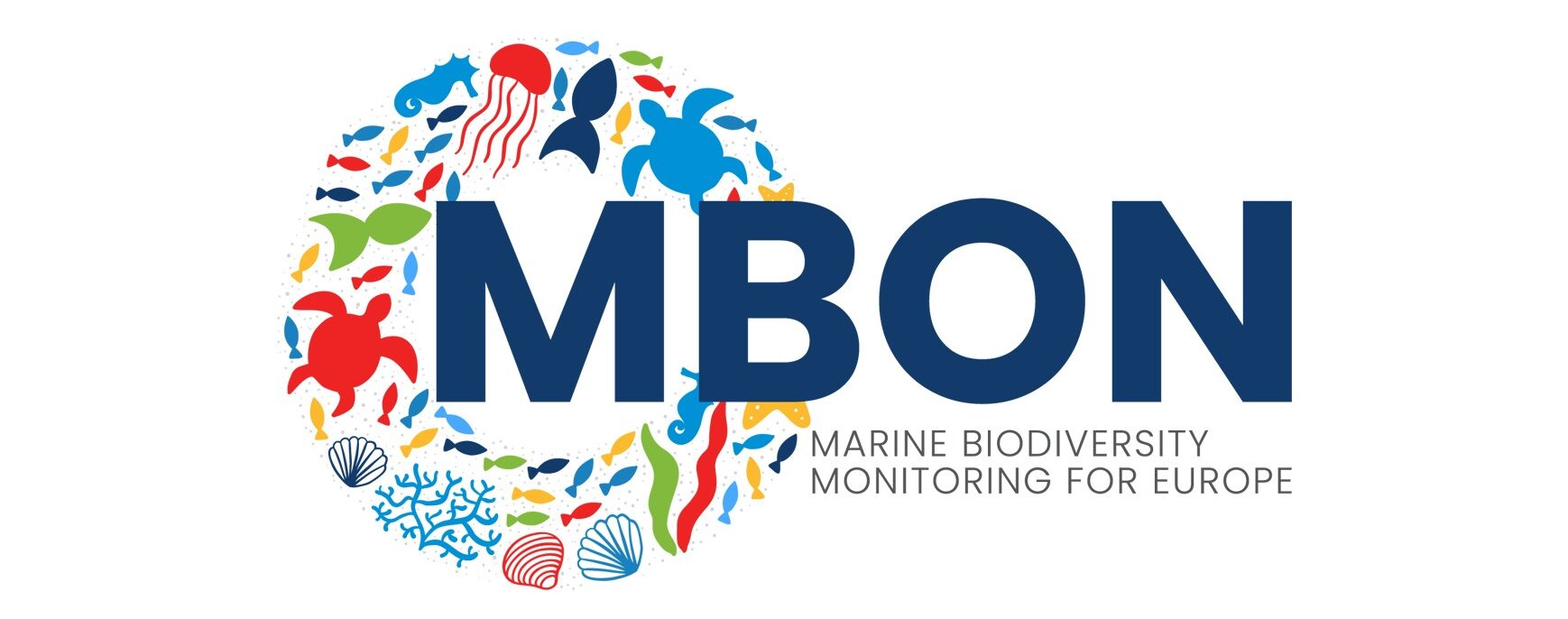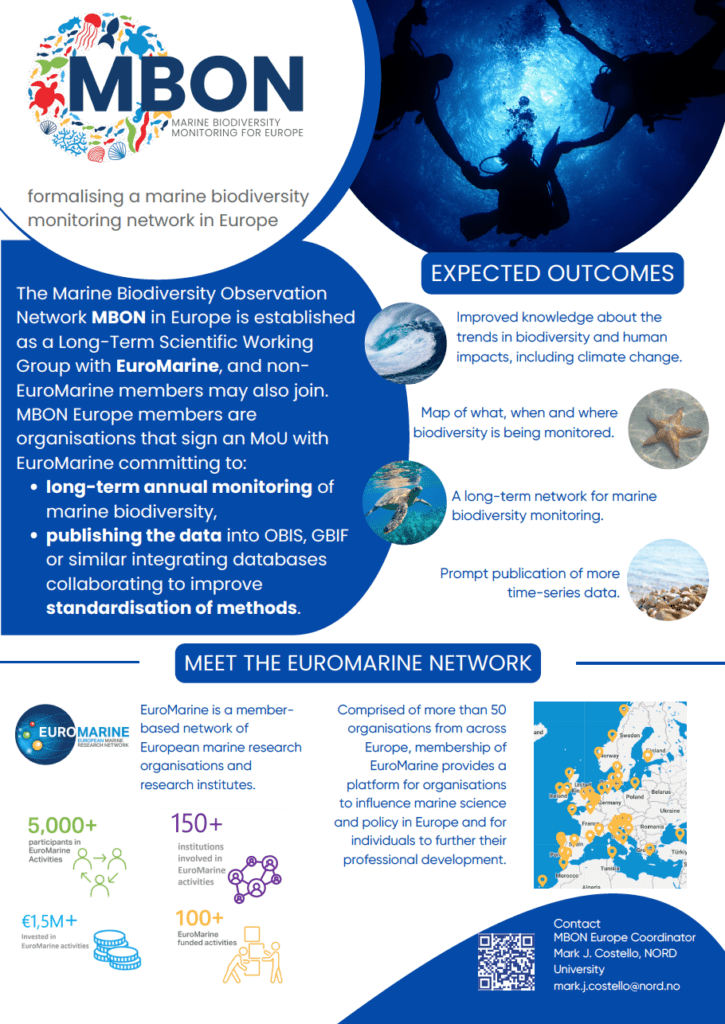Long term monitoring, or time-series data, are the only way we know how biodiversity is changing in time. This knowledge and understanding has become more in demand because climate change now adds to the existing human impacts, including fishing and pollution. It enables confirmation and correction of models predicting changes in biodiversity.
For decades we have seen short-term efforts to coordinate and increase the collection of repeated and comparable marine biodiversity data, sometimes within particular habitats like shallow sediments and rocky seashores. These “time-series” datasets vary by habitat, frequency of sampling and species identified, and may be called “monitoring”. However, when short term project funding ends the coordination ends. We no longer know if the monitoring has continued or not. MBON-Europe will provide a permanent structure to recognise where, when and what marine biodiversity is being monitored in Europe.
Marine biodiversity monitoring is typically led by enthusiastic scientists. However, they cannot do the monitoring forever. Thus, a key task of MBON Europe is to make such monitoring a normal part of operations at an organisation, be it a field station, university, or government institute. To this end, we propose an MoU that will state a commitment by an organisation to long term monitoring of marine biodiversity to be signed between each MBON Europe participant and EuroMarine.
A significant advance since 2000 has been the development of standards for data formatting that aid its publication into global databases that integrate thousands of diverse biodiversity datasets, notably the Global Biodiversity Information Facility (GBIF) and its marine equivalent the Ocean Biodiversity Information System (OBIS). Monitoring is not complete until the data are published. Thus, the publication of datasets into OBIS (or GBIF) is a key measure of the success of marine biodiversity monitoring.
The idea of long-term monitoring of marine biodiversity is an old one, with many previous efforts (e.g., BioMARE). In recent decades, policy-relevant scientific insights from such data are being published in top journals because they show how human impacts, including climate change, are altering the natural environment. This demand increases the value of past and present biodiversity monitoring data.
MBON Europe will benefit the science by getting formal institutional recognition of marine biodiversity monitoring. It fits perfectly within the goals of the Group on Earth Observations, UN Decade of Ocean Science for Sustainable Development on “MarineLife2030 Programme”, UN Sustainable Development Goal 14 (life underwater) and Convention on Biological Diversity goals and targets (formerly Aichi Targets, now Global Biodiversity Framework).
Both Horizon Europe and BioDiversa calls for research projects have noted the need for supporting marine biodiversity monitoring and associated data analysis. MBON Europe will provide a ready-to-go network of organisations actively doing such monitoring and who could contribute to such research projects. MBON-Europe participants are thus well positioned to apply for funding for projects that require empirical data on trends in biodiversity over time and which can be placed in to a regional and global context.
Several MBON-Europe participants are collaborating with MarineGEO, led by the Smithsonian Institution and a core part of MBON globally, including MarineLife2030. MBON Europe will provide a forum to expand MarineGEO time-series and ecological experiments in Europe.
MBON Europe will provide opportunities for participants to compare best practice, exchange taxonomic skills, test and develop new methods including automation of sampling (e.g., video and photograph image analysis). There are likely to be serendipitous benefits to participants not presently imaged.
Government policy and society benefit from knowing how marine biodiversity is changing, for example local impacts due to pollution or over-fishing, marine litter, regional effects of climate change on species distributions, and the spread of invasive species. When the evidence is available then people and their governments are motivated to reduce such negative impacts. However, the necessary data are rarely accessible in a coordinated or timely way to inform society. The best understanding of change in biodiversity, including its causes and significance, is achieved when local studies can be placed into a regional and global context. For example, the local decline of a valued species may be due to some local impact or be part of a regional scale phenomenon, and knowing trends over decades is necessary to best understand the natural dynamics in ecosystems. Research projects cannot achieve the delivery of time-series data because of their short-term nature. The monitoring of biodiversity data needs to be mainstreamed into the annual operations of research organisations, with cost efficient and timely publication of standardised data that enables rapid analysis of trends in space and time.
In addition, the involvement of citizen science is being encouraged in Europe. The Reef Life Survey is part of the global MBON and depends on citizen science scuba divers and is ready for development in Europe. There are other examples, e.g. hundreds of European and Marine projects in iNaturalist, Jellywatch, Medjelly, eBird , Observadores del Mar (Sea Watchers), national recording programmes, and opportunities for citizen engagement. MBON Europe could also include citizen science initiatives to widen its data collection and improve public engagement.
In some cases monitoring occurred inside and outside Marine Protected Areas. European countries have committed to increasing MPA cover to 30% by 2030. There will be some demand for monitoring in these MPA to see if protection results in a restoration and recovery of biodiversity.
MBON Europe will benefit the science by getting formal institutional recognition of marine biodiversity monitoring. It fits perfectly within the goals of the Group on Earth Observations, UN Decade of Ocean Science for Sustainable Development on “MarineLife2030 Programme”, UN Sustainable Development Goal 14 (life underwater) and Convention on Biological Diversity goals and targets (formerly Aichi Targets, now Global Biodiversity Framework).
Both Horizon Europe and BioDiversa calls for research projects have noted the need for supporting marine biodiversity monitoring and associated data analysis. MBON Europe will provide a ready-to-go network of organisations actively doing such monitoring and who could contribute to such research projects. MBON-Europe participants are thus well positioned to apply for funding for projects that require empirical data on trends in biodiversity over time and which can be placed in to a regional and global context.
Several MBON-Europe participants are collaborating with MarineGEO, led by the Smithsonian Institution and a core part of MBON globally, including MarineLife2030. MBON Europe will provide a forum to expand MarineGEO time-series and ecological experiments in Europe.
MBON Europe will provide opportunities for participants to compare best practice, exchange taxonomic skills, test and develop new methods including automation of sampling (e.g., video and photograph image analysis). There are likely to be serendipitous benefits to participants not presently imaged.
We expect the following outcomes from MBON-Europe:
- MOU signed between MBON Europe participants and EuroMarine.
- Formal recognition of MBON Europe as representative of MBON in Europe by the GEO BON MBON Steering Committee and inclusion on the MBON website.
- MBON Europe is recognised as an Action within the Ocean Decade programme MarineLife2030.
- Information on what biodiversity is being monitored where and when in European seas by EuroMarine members.
- A regularly updated map of where and what kinds (habitats, taxa, methods) of marine biodiversity monitoring is underway in European seas by EuroMarine members, for example at the GOOS BioEco Metadata Portal.
- A scientific paper published that synthesises the current status of biodiversity monitoring in European seas.
- A strategy to ensure that the delivery of coordinated marine biodiversity monitoring is optimised in the long term.
- Time-series data on marine biodiversity from EuroMarine members published through EurOBIS, OBIS, EMODnet and/or GBIF.
- Increased membership of EuroMarine as other organisations see the value of joining MBON Europe.
- EuroMarine members collaborating as part of bidding consortia for Horizon Europe and Biodiversa funding.

